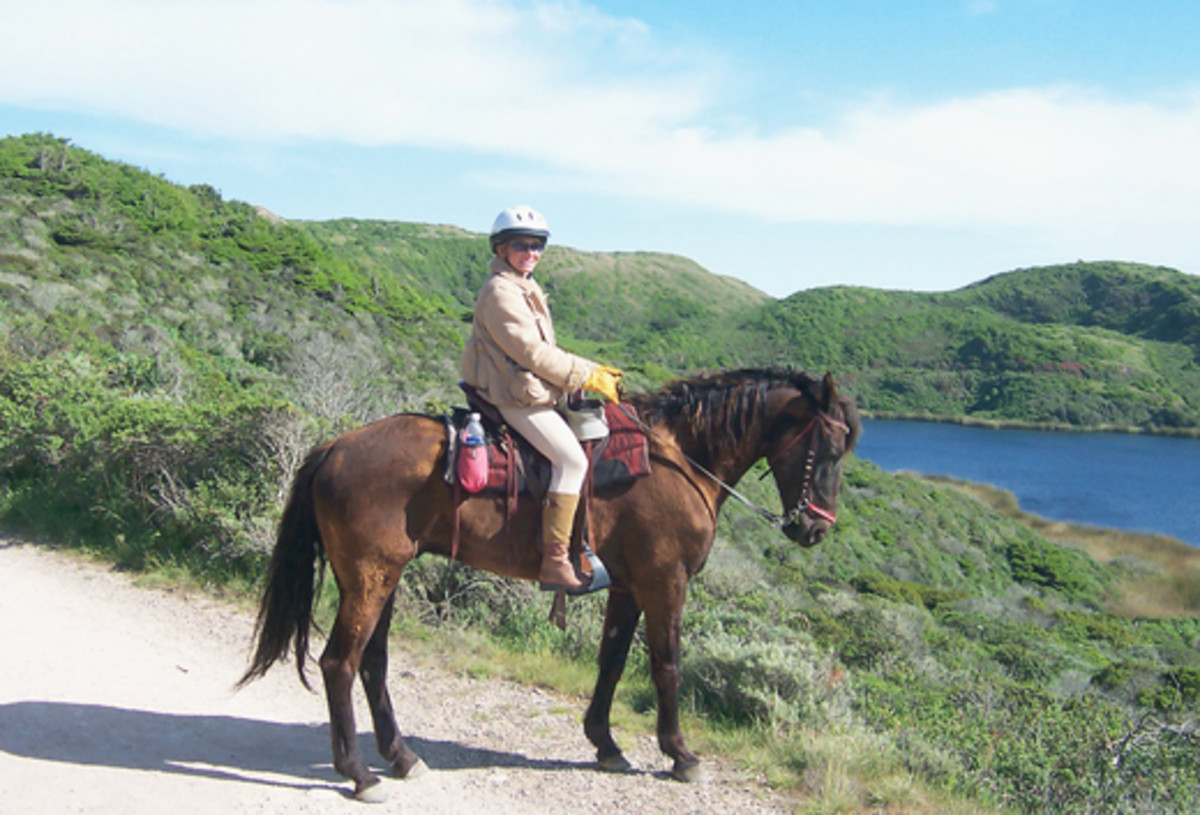
Scattered clouds in a pale blue sky and a gray sea framed the Farallon Islands on the horizon. Rugged cliffs and a narrow strip of white sand pointed to the Alemere Falls, where they plunged into the ocean. My riding partner, Susanne Haug, and I rode high on the bluff along the Coast Trail at Point Reyes National Seashore, then followed switchbacks down to Wildcat Beach. There, we let our horses drink at a freshwater stream that meandered through the sand.
Two-and-a-half miles down the beach, the falls beckoned us. I knew we had arrived precisely at low tide, but it appeared from wave patterns on the dry sand that high tide would reach the cliffs. I hesitated, reluctant to venture away from our access to higher land.
Susanne assured me we’d be keeping an eye on the diminishing beach as we set off to the falls. I began to relax as the beach seemed to widen. Still, I knew the tide was coming in. We played with the horses as the foamy water approached us, then receded. Both horses accepted the waves’ motion with grace.
When we arrived at the falls, a nice young hiker offered to take our photo. He and his friend had climbed down to the falls along a narrow cliff trail that he said wouldn’t be suitable for horses. I asked him if he knew whether the beach would be covered at high tide. He suddenly looked worried and said, yes, and by the way, maybe we’d better get going. At the angle the tide comes in, the other end of the beach is covered first, which could cut us off. My worry turned to near panic!
“Susanne!” I called, as I began walking back. “Hurry!”
Susanne later teased that she’d never seen me move so fast. I told her we had to ride back fast. We got some great gaiting on the beach the entire way, reaching the other end when only a ribbon of beach was left.
Located 22 miles north of San Francisco, Point Reyes boasts of pristine beach front and coastal forest trails. You can plan your own route, or go on one of seven good routes offered by the park trail guide, which range from five to fifteen miles long. We chose more than one route per day so we could ride longer. The nice folks at the visitors’ center give out free maps and lots of friendly suggestions. They also post low/high tide times-important if you’re going to the falls. First-time visitors are encouraged to learn as much about the area as they can before heading out onto the trails. Although the trails are well groomed, they’re remote.
The weather was perfect the entire six days we spent at Point Reyes. We spent about nine hours on the trail each day we rode. (We challenged the tide at Wildcat Beach on our final day.) On the fifth day, we let our horses rest and drove to the Point Reyes Lighthouse, then to see the tule elk, which live at the northern end of the park.
I can’t say which trail was my favorite, as they’re all wonderful. One trail was marked “not maintained,” but since it was open, we gave it a try. We ended up ducking under or climbing over quite a few deadfalls. That trail made us appreciate the work it takes to keep the main trails so well groomed.
We did get lost on that trail, but luckily, it was early in the day, so we had plenty of time to get our bearings. Being desert folk, we were fooled by the overcast day. Without the sun, we lost our sense of direction. We studied our maps and trail signs, and finally, after much deliberation, chose a new destination. It turned out to be a spectacular ride.
Getting lost made me realize how grateful I am to have such a considerate riding partner as Susanne. She’s a safe rider who’s always cheerful and keeps her head when the going gets tough. We’re probably both unwise in that we travel far each day and
usually return to camp at dusk, which doesn’t leave much room for error. But luckily, each evening found us comfortable in camp, our horses happily munching hay.
For more information, contact the Point Reyes Visitor’s Center, (415) 663-109; visit www.nps.gov/pore/home.htm. For stabling information, call Stewart Horse Camp at (415) 663-1362.






